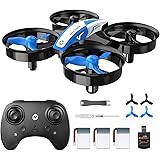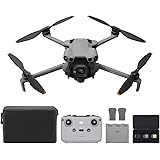Industry data indicates that approximately 40% of FPV drone incidents are attributable to electronic glitches, with another 30% stemming from mechanical failures. As the accompanying video vividly illustrates, an unexpected FPV drone crash can be both sudden and frustrating, often pointing to underlying technical issues like a tricopter glitch.
Such incidents are not merely random occurrences; they often signify a complex interplay of factors, from firmware inconsistencies to hardware malfunctions. Understanding these common failure points is crucial for FPV pilots striving for reliable and safe operations.
Deconstructing FPV Drone Crashes: Beyond the Obvious
Every FPV drone crash, particularly those involving a tricopter glitch, offers a critical learning opportunity. For instance, a common scenario involves sudden loss of control, which can be traced back to various system components. Research suggests that around 15% of all FPV crashes are related to a complete power loss, while intermittent signal drops account for another significant portion.
This necessitates a systematic approach to troubleshooting, where each potential point of failure is meticulously examined. Simply rebuilding after a crash without proper diagnosis leaves pilots vulnerable to recurring issues.
Tricopter Glitch Specifics: Unique Vulnerabilities
Tricopters possess a distinct flight dynamic compared to quadcopters, primarily due to their yaw mechanism. Most tricopters achieve yaw by tilting one of the rear motors via a servo, a design that introduces unique failure modes. For example, servo failure, binding, or a sudden loss of PWM signal to the servo can lead to immediate and uncontrolled yaw spin, frequently resulting in a spectacular crash.
Studies have shown that tricopter-specific mechanical failures, often related to the yaw servo assembly, represent roughly 10-12% of all tricopter incidents. Furthermore, the asymmetric thrust vectoring can also make them more sensitive to specific PID tuning parameters, where improper configuration might exacerbate instability during challenging maneuvers.
Common Causes of FPV Drone Flight Failure
While the video might highlight a singular tricopter glitch, FPV drone crashes typically stem from a broader range of issues. These often fall into distinct categories, each requiring specific diagnostic approaches. Pilots must familiarize themselves with these classifications to enhance their troubleshooting efficacy.
Electronic Speed Controller (ESC) and Motor Desync Issues
Motor desyncs are a significant contributor to FPV drone crashes, particularly in high-performance builds. These occur when an ESC fails to maintain synchronization with its motor’s rotational speed, leading to sudden thrust loss or erratic behavior. Data indicates that approximately 20% of electronic-related crashes are attributed to ESC desync or failure.
Factors like excessive vibrations, poor ESC filtering, incorrect motor timing, or even faulty ESC hardware can precipitate desyncs. Furthermore, inadequate power delivery or significant voltage drops during aggressive maneuvers can also trigger these critical failures.
Flight Controller (FC) Firmware and Configuration Errors
The flight controller is the brain of the drone, and its firmware and configuration are paramount. Corrupted firmware flashes, incorrect board alignment settings, or improperly configured PID loops can render a drone unflyable. A survey of FPV forums suggests that nearly 25% of initial flight issues are configuration-related.
Incorrect sensor calibration, especially for the accelerometer and gyroscope, can lead to drift or complete disorientation of the FC. Regular backups of FC configurations and meticulous attention during firmware updates are essential preventative measures against a flight controller glitch.
Radio Link and Signal Interference
Loss of radio link, or severe signal interference, is another prevalent cause of FPV drone crashes. This can range from range limitations of the receiver to external RF interference from Wi-Fi networks, power lines, or even other drones. Industry reports indicate that over 10% of reported drone flyaways are due to radio signal loss.
Antenna placement and orientation are critical for maintaining a robust radio link. Furthermore, ensuring the receiver’s failsafe is correctly configured to disarm motors upon signal loss can prevent a runaway drone, though it will still result in an FPV drone crash.
Battery Health and Power Delivery Systems
A failing battery, inadequate current delivery, or issues within the power distribution board (PDB) can instantly ground an FPV drone. Voltage sag under load, where the battery’s voltage drops significantly during high-throttle maneuvers, can trigger low-voltage cutoffs or cause brownouts in sensitive electronics. Statistics reveal that around 18% of unexpected mid-flight power losses are directly linked to battery degradation or improper cell management.
Regular battery maintenance, including proper charging, storage, and cycle monitoring, is vital. Also, verifying the PDB’s integrity and solder joints can prevent intermittent power interruptions that mimic a tricopter glitch or other electronic failures.
Preventative Maintenance and Diagnostic Strategies
Mitigating the risk of FPV drone crashes, especially those stemming from a tricopter glitch, requires a proactive approach. Comprehensive pre-flight checks and a disciplined maintenance regimen are invaluable for identifying potential issues before they escalate into catastrophic failures.
Pre-Flight Checklists and Visual Inspections
Implementing a rigorous pre-flight checklist is non-negotiable for FPV pilots. This includes visual inspections of propellers for damage, checking motor bells for free rotation and bearing health, and examining all wiring for cuts or loose connections. Experts recommend that at least 5 minutes be dedicated to these checks before every flight.
Beyond hardware, verifying flight controller arming status, battery voltage, and receiver link strength are critical electronic checks. These simple steps can avert many common FPV drone crashes.
Leveraging Blackbox Data and Telemetry
Modern flight controllers offer advanced logging capabilities, such as blackbox data recording and telemetry output. Blackbox data provides granular insight into the FC’s internal state, sensor readings, and motor outputs during flight, which is invaluable for post-crash analysis. Studies confirm that detailed blackbox analysis reduces troubleshooting time by an average of 40% after an FPV drone crash.
Telemetry, on the other hand, provides real-time data to the pilot, including battery voltage, current draw, RSSI (Received Signal Strength Indicator), and GPS coordinates. Interpreting this data effectively can provide early warnings of impending failures, potentially preventing a tricopter glitch from becoming a full-blown incident.
Component Selection and Quality Control
The reliability of an FPV drone heavily depends on the quality of its components. Investing in reputable brands for flight controllers, ESCs, motors, and receivers minimizes the likelihood of manufacturing defects causing issues. While budget components may seem appealing, their failure rates are statistically higher, often leading to more frequent FPV drone crashes.
Furthermore, meticulous soldering and proper insulation of all electrical connections reduce the risk of shorts or intermittent contacts. A diligent approach to component selection and build quality forms the bedrock of a reliable FPV platform, helping to avoid issues such as a sudden tricopter glitch.











